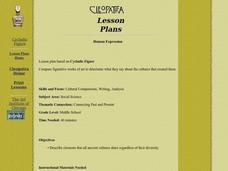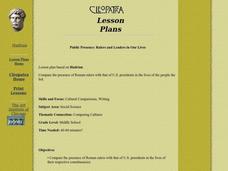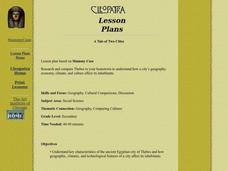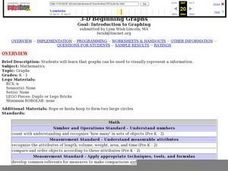Curated OER
Ancient and Modern Diets
Pupils investigate the ancient Egyptian diet and compare it to the contemporary American diet.
Curated OER
Human Expression
Middle schoolers compare figurative works of art to determine what they say about the cultures that created them.
Curated OER
Public Presence: Rulers and Leaders in Our Lives
Students compare the presence of Roman rulers with that of U.S. presidents in the lives of the people the led. They complete a worksheet imbedded in this lesson plan.
Curated OER
A Tale of Two Cities
Students research and compare Thebes to their hometown to explain how a city's geography, economy, climate, and culture affect its inhabitants.
Curated OER
Burial Practices and Memorials
Learners compare and contrast burial practices in ancient Egypt, the former Soviet Union, and the United States.
Curated OER
Ancient Abstraction
Students compare and debate how an ancient Greek sculpture is similar to modern art. Then they orally describe the cultural contributions of early Greek civilization and their relationship to the modern world.
Curated OER
Water Plan for Dryville
Students use the internet to read about the water plan for Dryville. They work in small groups to develop a picture representation of each phase of the story. Students assemble their illustrations to create an entire illustrated edition...
Curated OER
Form, Story, and Function: Then and Now
Students compare the function and decoration of everyday objects from ancient Greece and today's world. They complete a chart imbedded in this lesson that enables them to compare today's objects to objects of the past.
Curated OER
3-D Beginning Graphs
Students explore the concept of big and small. They collect objects from the classroom, sort them by size, and create a graph using Duplo stacking blocks.
Curated OER
Feathers, Flippers and Feet
Second graders read, "Feathers, Flippers and Feet." In groups, they research important information about feathers and wings. They discover why feathers and wings are important to animals. Students create a presentation to share with the...
Crescent Public Schools
The Internet Science Room: Percentage Composition and Empirical Formulas
Students learn how to find percentage composition, the percentage of a formula mass represented by each element. Percentage composition compares the mass of one part of a substance to the mass of the whole.
Alabama Learning Exchange
Alex: Fraction Fun
The students will participate in a hands-on instructional activity about dividing a whole object into parts. They will also practice simple addition.This lesson plan was created as a result of the Girls Engaged in Math and Science...
Alabama Learning Exchange
Alex: Understanding Fractions
In this lesson the children will demonstrate parts of a whole using a candy bar (or fruit), and piece of paper. The activities are used as instructional plans to help students better understand shapes and parts of a shape up to a whole....
Alabama Learning Exchange
Alex: Beyond the Earth Part I
Students will access prior knowledge of the solar system by completing a graphic organizer. After participating in a teacher lecture and whole group discussion, the students will work in collaborative groups to create a...
Cornell Lab of Ornithology
Habitat Network: Habitat Connectivity in the Yard
Habitat Network address how yards can positively contribute to the overall landscape matrix sharing some ideas about how to see a backyard as a part of the greater whole.
Alabama Learning Exchange
Alex: "Fantastic Fractions"
The students will use sugar-free Gummy bears to identify fractional parts of the whole. The students will create a graph using the information obtain.This lesson plan was created as a result of the Girls Engaged in Math and Science...















